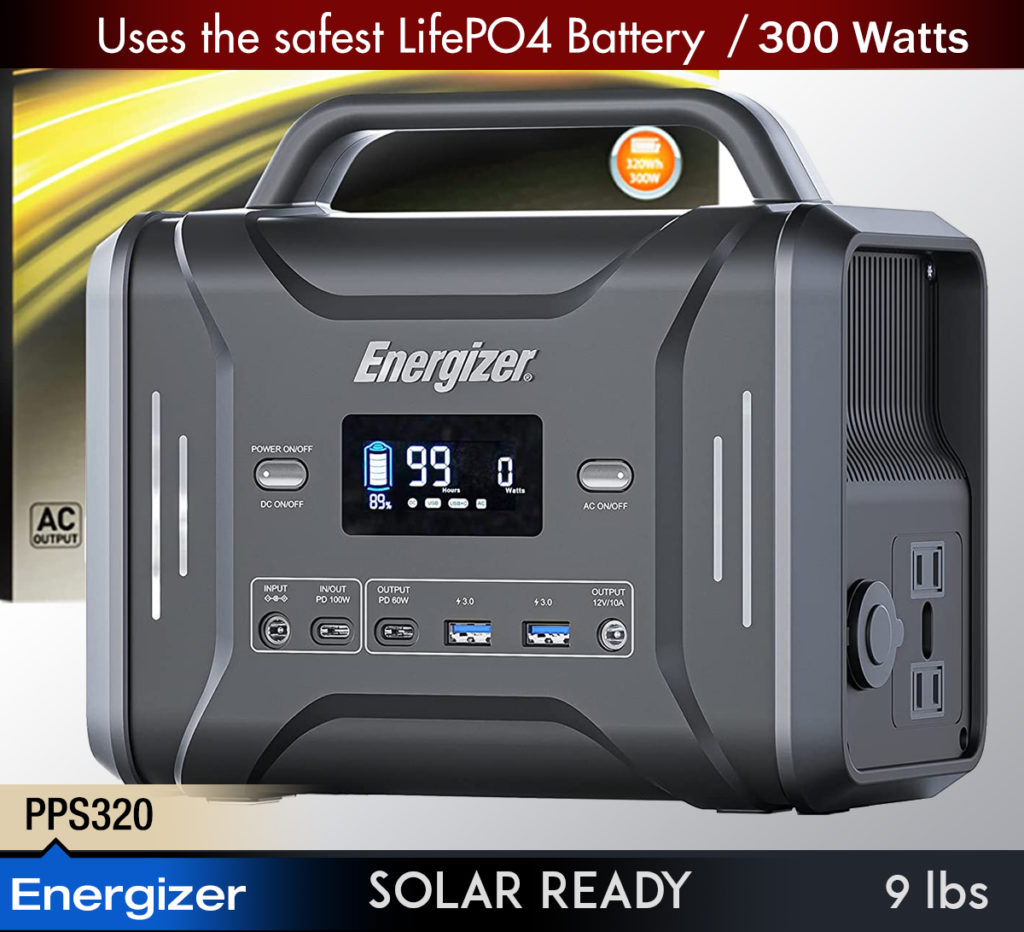
In this review of the Energizer Portable Power Station (PPS240W01) you’ll discover that it’s quite underrated but it shouldn’t surprise anyone since Energizer knows the art of making premium battery related products. I’m shocked they don’t have a full lineup of battery generators already. What are they waiting for? Energizer’s power stations have a few features that other indoor generator manufacturers do not have, like a full fireproof enclosure. Safety comes first with Energizer power stations, which all customers will benefit from.
We also compare it to several other popular power stations so you can see what your options are. You’ll also be happy to discover a new power station from Energizer — the PP320W01, a 320W compact model weighing only 9 lbs. It’s just hitting the market as I write this. It’s an exciting time for battery-powered generators.
Portable Power Stations —
We live in a digital age, where every person is constantly connected to the rest of the world via internet. Computers and phones are what we use for work, whether it be at office or home. And if you really think about it, electricity is what makes the world go around. Take that away, and you might as well be living in a Mad Max movie. While power outages are rare in most parts of the country, they can happen at any time and without warning. Hurricanes, earthquakes, floods, etc. can cause severe damage to the power lines and it might be several hours or even days before you can turn the lights back on. Imagine you and your family living without air conditioning or a functional fridge for more than a few days.
Excellent Power Station / EF ECOFLOW RIVER PRO
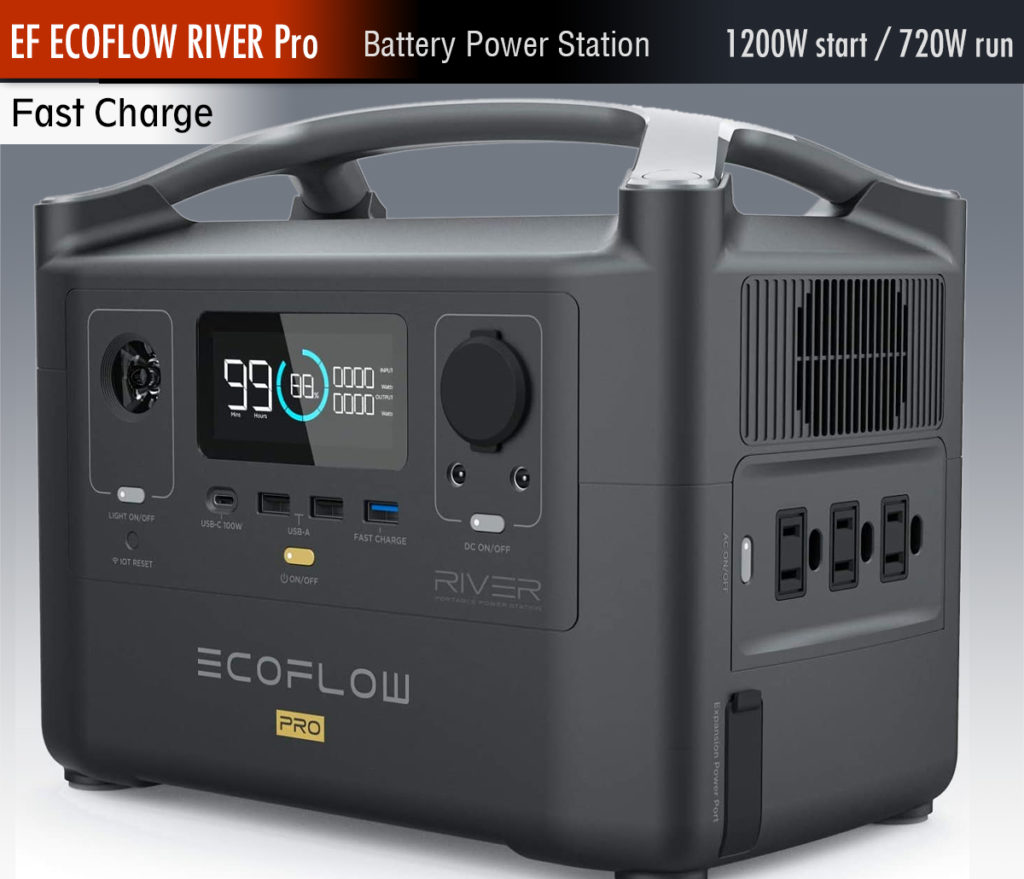
In scenarios like these, you need some form of backup power. Today, I am going to review some of the most compact portable power stations. These little fellas pack enough juice to keep essential appliances running for a day or two. If you want serious backup power because you live in hurricane country, you might want to look at a portable gas generator. Or a larger power station, such as the Goal Zero Yeti 6000x. There are also upper mid-range portable power stations rated for over 1000 watts of continuous supply, like the EcoFlow Delta and EGO Power+ PST3041 Nexus. If you want to power your fridge or CPAP machine, I recommend a power station with at least 500Wh of capacity (ideally you want 1000Wh and above).
Compact portable power stations with 300Wh or lower capacity are designed to charge your phone and laptop. These help you work and stay in contact with friends or family during a blackout. They are also excellent for bringing with you on camping or hiking trips because you can easily run some LED lights and a radio with them. Or even an electric blanket. Today, I’ll review a few of these compact portable power stations. My focus will be on the Energizer PPS240W01 which is an excellent piece of kit for everyone from campers to DIY’ers. It won’t run your power tools or fridge, but can easily charge a Go Pro, MacBook, iPhone, etc. Plus, it has every port you need from USB Type-C (with power delivery) to 120V AC. Energizer is also a reputable brand when it comes to battery and inverter technology. You know the product is built to last unlike some of those fly-by-night Chinese brands you see on Amazon these days.
Brand Names | Do they Matter?
What’s in a name? Quite a lot, at least if you’re talking about the portable power station market. These are essentially giant lithium ion batteries hooked up to inverters, there’s a lot of electronics and heavy gauge wiring involved. You don’t want to buy a power station from that one company which cut corners on build quality (unless you want a portable fire hazard). Sure, they might advertise their product as a “pure sine wave” generator, but not all sine waves are the same. For instance, the power you get from your utility company at the wall is extremely clean. The power you get from a cheap Walmart generator… not so much. Small variances in the waveform and voltage can severely damage sensitive microchips like the kind that’s used in your computer, phone, TV, game console, etc.
That’s why I take portable power quality very seriously. Not just the quality of the electricity, but that of the actual machine itself. Is the plastic rugged? How efficiently do the cooling systems work? After all, inverting all that DC energy into AC does generate a fair bit of heat. And if it isn’t dissipated properly, the battery in your portable power station will degrade more rapidly. Recently with the Covid-19 scare, a lot of people have been looking up portable power stations on Amazon. And with this surge in demand, there are a few companies looking to make a quick buck. Most of these are shady Chinese brands. Look, I’m not saying all Chinese stuff is poorly made. After all, a lot of the components in a Yeti or Jackery Explorer are made in China. Your MacBook and iPhone are also made there. And those are quality products, so it all comes down to standards and QC.
New Energizer AC (PP320W01) : More Power
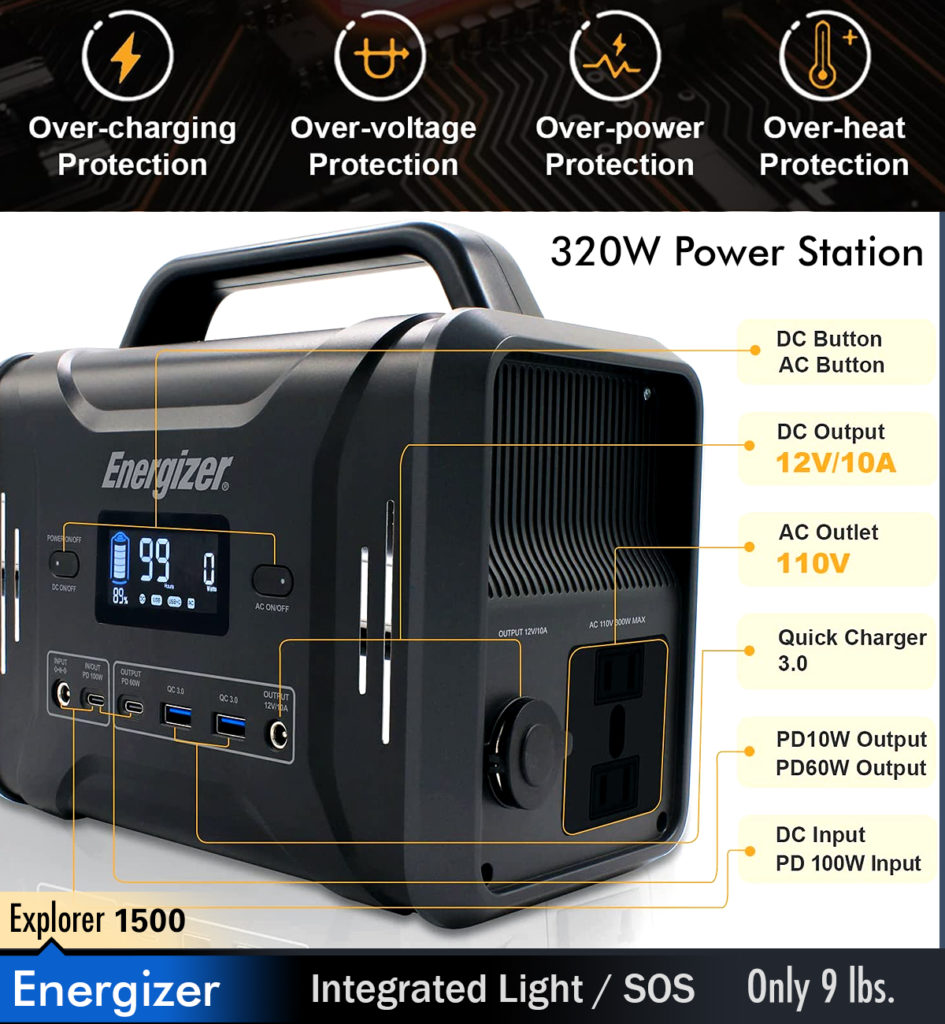
If your cheapo-brand power station breaks down 4 months after purchase, good luck getting them to honor the warranty. Most likely, you won’t even find a human on the other side of that phone call. Brands like Energizer, Jackery, and Goal Zero have extremely robust products with reliable customer service and long warranties. The extra cash you pay in the short term will pay dividends a few years down the line, because your product will get fixed for free as long as it’s within warranty. These companies have service centers all around the country with well trained support staff. Even when the warranty expires, it’s easy to find spare parts for a Jackery or Energizer power station.
In a nutshell — STICK TO NAME BRANDS. You have to think long-term when it comes to any type of generator and/or expensive tools. When your product breaks down who are you going to call? Are parts available? Most people overlook this simple fact but I can asure you, part availability is absolutely essential. Would you buy a brand new car knowing that when it breaks down you won’t be able to find the needed parts? And if parts were available, would you buy a new car knowing you might have to wait weeks to have the parts shipped to your mechanic? Think about it. There are a lot of cheap portable power stations on the market nowadays but they don’t compare to reputable brands. Brand does matter.
What Can You Run With A Portable Power Station?
Understanding peak vs continuous power and Wh (watts per hour)
It all comes down to the capacity of your power station. More capacity means it stores more electrical energy, and can output higher continuous/ peak watts. Talking of continuous and peak watts, these are the two metrics by which we can judge the performance of a power station. Certain appliances (the ones with inductive loads) require a lot more power to start than they do to run. Think stuff like compressors, pumps, etc. Your air conditioner or fridge actually draws around 2 or 3 times its running watts whenever the compressor spools up.
This is why you should always keep the fridge or freezer filled up to around 75% capacity for optimal efficiency, especially if you are expecting power cuts. Just use water bottles if you haven’t got anything else, that way the compressor won’t have to cycle as much and the residual energy within the fridge from all those cold water bottles will prevent temperature from dropping too low. This is also a great way to extend the runtime on portable power stations if you are using one of those to power your fridge/ freezer.
Complete with Solar Panels / Jackery 1000 (Charge with the sun)
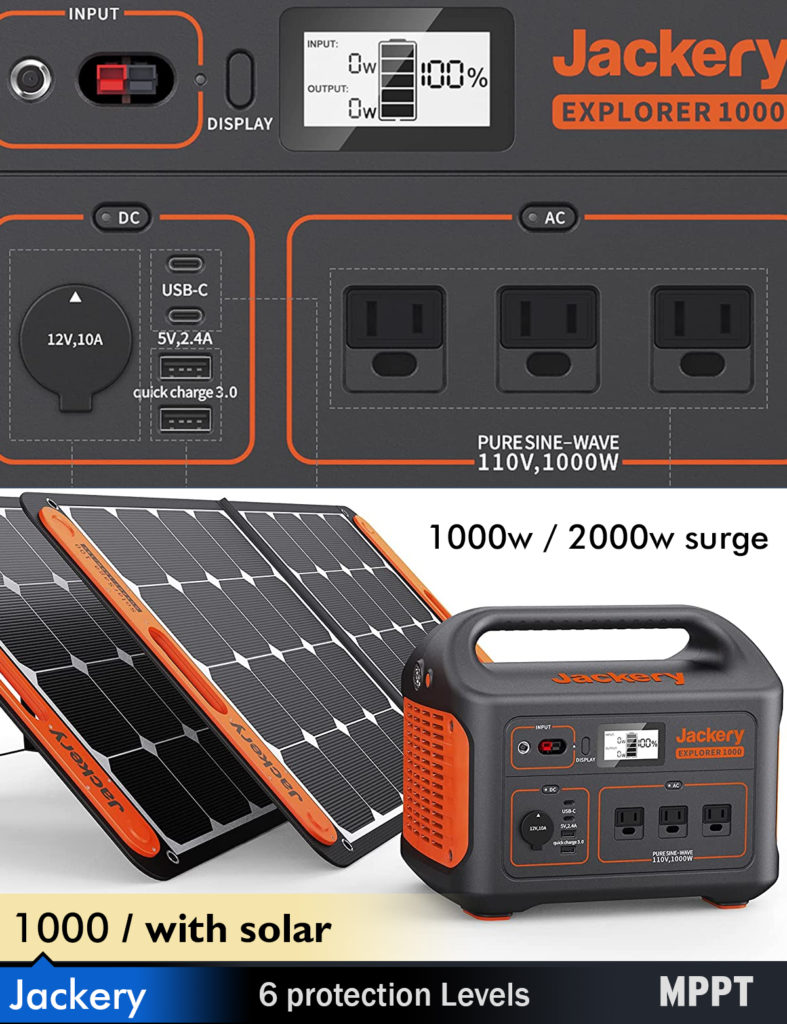
Peak or starting watts indicates the amount of watts a portable power station can generate for extremely short bursts of time. This is usually 50 to 100 percent above continuous power. The burst tends to last for a couple seconds at max. Why can’t a power station sustain this output for extended periods of time? Well, simply put it will damage the electronic circuits and drain the battery a lot quicker. Not to mention, overheat the power station. Continuous or rated watts is what you should look at if you need to power appliances with a power station. This is the amount of power it can delivery safely over extended periods of time.
Now, let me talk about Watt-hours and what they signify. A watt is simply the unit used to measure power, or work done over time. Watt-hour is a measure of energy, obtained by multiplying power with time. So a 10Wh battery can power a 10W light-bulb for one hour. Or a 5W bulb for 2 hours. Get the idea? Similarly, a 100Wh power station can supply 100 watts for up to one hour before running completely dry. For perspective, most laptop battery capacities range between 50 and 100Wh. Laptops top out at 100Wh because that’s the legal maximum battery size you’re allowed to bring on airplanes (referring to carry-on items). With an Energizer PPS240W01 which is a 240Wh power station, you can recharge your MacBook Pro twice and still have energy left over to charge your phone.
The easiest way to figure out a power station’s continuous wattage is by looking up its capacity. For example, company “A” makes a power station with a capacity of 500Wh. You can assume with reasonable accuracy that it will have a continuous rating between 400 to 500 watts, and a surge rating around 750 to 1000 watts. Of course, this is not always the case. Older designs with NiMH batteries often have continuous wattage figures that are significantly lower than their capacity in Wh. Which is why modern lithium-ion battery equipped power stations are so much better. Lithium-ion has more energy density, i.e. it holds more charge per unit mass. It can also recharge and discharge at much faster rates compared to nickel metal hydride/ lead acid batteries. Of course, it always helps to look up the performance data before you purchase a power station. And I’ve got all the performance figures you need in this review.
Alright, so you’ve got your brand-new portable power station with a continuous rated wattage of 500. You looked at the sticker on the back of your fridge, and it says that power consumption is 200 watts. So that means all is good, right? You just hook up the power cord of your fridge to one of the 120V AC outlets on the power station, and you should be good to go. Wait a second, how long do you plan to run that fridge? While it consumes 200 watts on average, that’s not telling the whole story. A typical home fridge has a duty cycle of 33%, so it stays on for a 3rd of the entire day. Which is 8 hours. Multiply that with 200watts, and you need 8h x 200W = 1600Wh of capacity to keep it running for one whole day. Your power station may have a maximum rated output of 500W, but it also has a capacity of just 500Wh (500 watts for one hour, or 200 watts for 2.5hrs).
Granted, most fridges have a conservation time of 15h which means the food won’t start spoiling until 15 hours after power failure. Still, you can’t expect to run your fridge off a 500Wh power station if you live in hurricane prone areas. The power might be out for days or weeks. And recharging via solar may take 8 to 12 hours depending on the size of your power station and the weather. That’s why I recommend at least 1000Wh of capacity if you’re looking to run a fridge or other appliances in your kitchen. Something like the Goal Zero Yeti 1500X or Eco Flow Delta is what you need. Compact power stations are fine for powering your laptop, camera, phone, etc. but don’t rely on them during emergencies to run critical appliances.
Energizer Power Station : What’s Different?
Unique features, such as FIREPROOF ENCLOSURE.
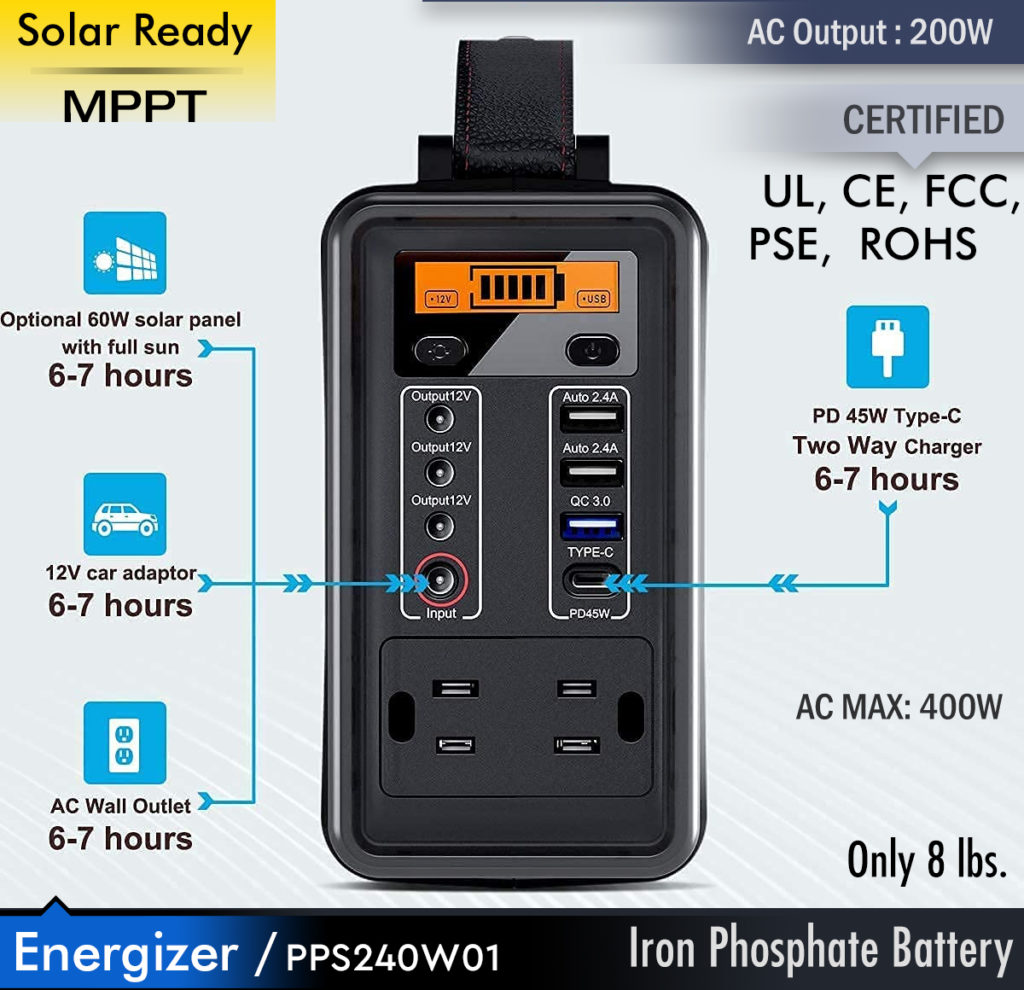
Features :
- Power Delivery : 45W USB-C output with Power Delivery technology that can provide steady charging for your Macbook and other laptops, fast charge to new iPhones from 0% to 50% in only 30 minutes, and other USB-C devices.
- QUICK Charging : Smart 18W USB-A provides fast charge for Samsung, Huawei, and other Android devices.
- AC output charges up to 220W small portable electronics, such as laptop, portable fan, mini juicer, car mobile refrigerator and other portable appliance.
- Perfect for traveling, hiking, camping, picnic and any other outdoor activities.
- ADVANCED Heat-Control : With the latest heat-control technology, using automatic air duct design and precise chip to dissipate heat (including built-in cooling fan).
- The DC input built-in MPPT, equivalent to having a solar energy converter. So PPS240W01 is compatible with most different wattage solar panels without sparks.
- Supports solar charging at a maximum rate of 22V / 2.5A 55W, as long as the solar panel’s open circuit voltage is less than 24V, it can be used.
OVERVIEW —
Quite a few things, primarily the battery technology. Most power stations use lithium ion batteries, whereas Energizer equips its power packs with lithium iron phosphate batteries (LiFePO4). LiFePO4 batteries have a longer lifespan compared to lithium ion, because they can take more charge cycles before dropping capacity. On a typical lithium ion battery like what you’d find in a Jackery Explorer, the battery will drop to 80% capacity after 500 charge cycles. So it will hold only 80 percent of its original charge (compared to when it was brand new). That means after 2 to 3 years of usage, you will either have to replace the battery or live with the decreased capacity.
On a LiFePO4 battery however, the number of charge cycles to 80% capacity is 2000. So it has literally 4 times the lifespan of a typical lithium ion battery. Even if you completely drained and recharged the battery from 0 to 100 percent every single day (that’s one charge cycle), for 5 years in a row, you still wouldn’t reach the end of its lifespan. With normal usage? You’re looking at about 10 years of consistent performance, which is incredible.
Lithium iron phosphate batteries also produce more voltage than standard lithium ion batteries. What does that mean in practical terms? A typical power station in the 200 to 300Wh range needs a regulated 12V power supply built in to run 12V appliances. Because its own battery doesn’t produce nearly as much voltage, the DC power has to be “stepped up”. With the Energizer power station, you’re looking at 13.6V DC power right at the battery. Even as it drains down, it never goes below 11.5V. So it doesn’t need a built-in 12V power supply to regulate or step up power, which means less wastage of energy. Other power stations with li-ion batteries have to use some battery energy for the transformation process which reduces runtime. So if you compare the Energizer PPS240W01 240Wh power station to any other 240Wh power station on the market, it will run longer while powering 12V devices. Think CPAP machines, 12V mini refrigerators, etc.
Review : Energizer Portable Power Station
PPS240W01 | Best Compact Power Station for the money
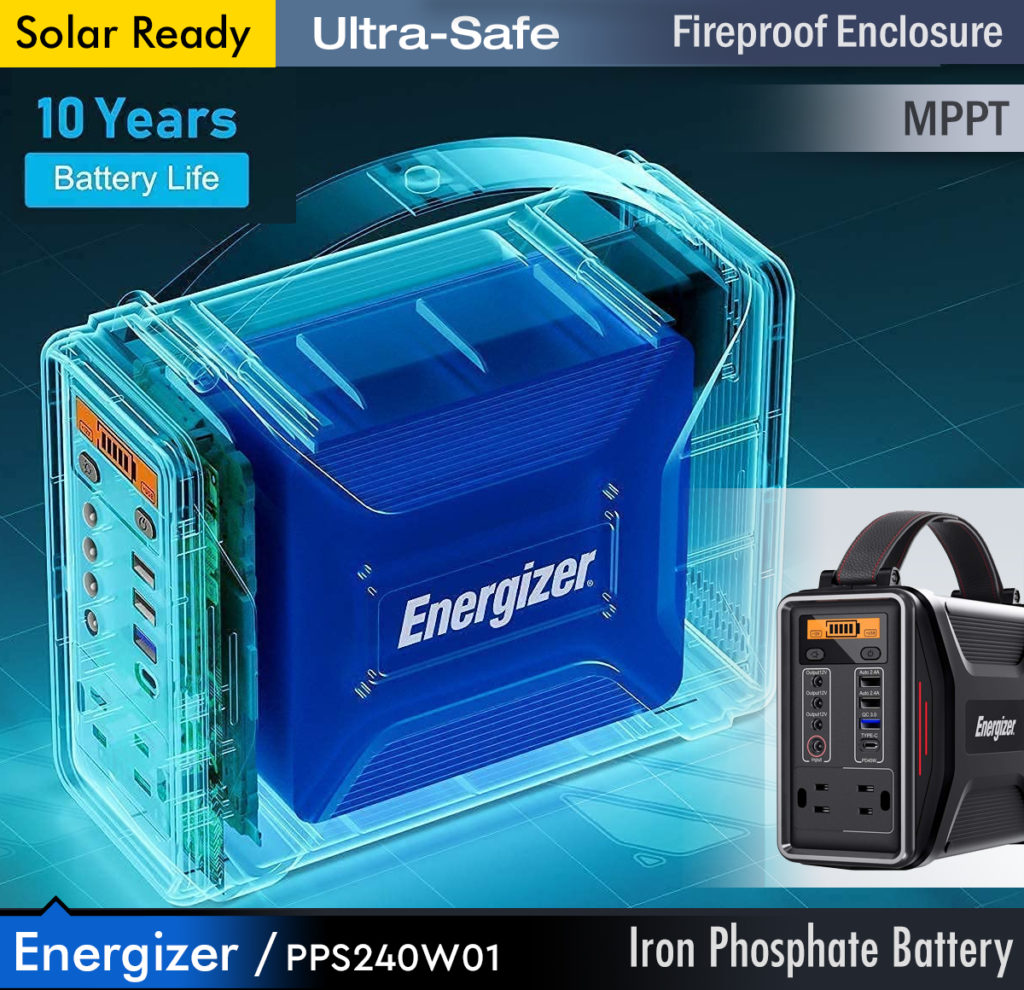
You might not have heard of Energizer’s power stations before, because most people tend to go for Jackery, EGO, Goal Zero, etc. The reason is simple- despite making some excellent products, Energizer doesn’t advertise nearly as much as the other companies. If you asked me what the best sub-300Wh power station is on the market, I would say it’s the Energizer PPS240W01. And that’s because it is equipped with an excellent lithium iron phosphate battery that outlasts every lithium ion battery in competing power stations.
The most direct comparison I can make to this Energizer power pack is Jackery’s Explorer 240. And while the Explorer 240 is getting a little long in the tooth, it’s still an extremely popular 240Wh power station. However, the PPS240W01 outclasses it in every possible way. For starters, even though they both have the exact same capacity (240Wh), Energizer’s model is smaller and weighs less. Plus, it feels more durable thanks to the thick fire retardant plastic shell. Now, I wouldn’t toss this thing into an open fire but hey- it’s nice to know that a short circuit won’t burn up your house.
Another huge advantage the PPS240W01 has is its battery type — LiFePO4 instead of regular lithium ion. On the official spec sheet, it seems to have a lower voltage than Jackery’s Explorer 240. The Explorer 240 is equipped with a 14.4V 16.8Ah battery while the Energizer has a 12.8V, 75Ah battery. In practice, the Energizer can hold its voltage much better as the battery drains. That’s just the nature of LiFePO4 cells. Besides, 3rd party reviews put the output of the Energizer battery at 13.6V which means they are underselling their specs. They do this in other places too, as you’ll find out. Kind of like sports car manufacturers who advertise a model as having 400hp when in reality it has 450hp. The car manufacturers do it to gain favorable reviews because their model ends up being compared to one with similar specs. With electronics though, things are different. Often you’ll find that power supplies and power banks can handle loads larger than official specs. At least with quality brands like Energizer, I can’t say the same for certain fly-by-night Chinese brands.
VIDEO | Watch Promotional Spot from Energizer
Because of its LiFePO4 battery, the Energizer power station doesn’t need a regulatory 12V power supply built-in. However, the Jackery Explorer 240 does because its voltage will drop a lot more as the battery drains and it has to step it up to stay within 12V output parameters. Another big win for the Energizer is in endurance. LiFePO4 lasts 4 times longer than lithium ion, quite literally. On the Jackery website, it states that their battery will reach 80% capacity after 500 cycles (each cycle is a complete discharge + charge). Which is standard fare for lithium ion. The Energizer battery on the other hand, will go through 2000 cycles before hitting 80% capacity. This is a power station you can pass down to your kids. Isn’t that something?
The PPS240W01 scores another massive win over the Jackery when we take a look at ports. While this power station has three 12V outputs and 4 USB ports (one of which is a Type-C with 2 way charging), the Jackery only has one 12V automobile outlet and 2 Type-A standard USB ports. The PPS240W01 has two 120V AC outlets, while the Jackery only has one. Not that you’ll be using those a lot, since both of these power stations are meant to supply DC power for charging laptops and phones, or running 12V appliances. Using the inverter will use up the battery faster, because converting DC to AC also requires power. Besides, 200 watts isn’t going to run any appliance other than a TV or Wi-Fi router. And not for long either.
Because it has two-way charging via Type-C, you can charge the Energizer power station with a solar panel that has USB output. Or you can share power between this power station and a 2nd power bank. It also has a quick charge USB port. Energizer has some extra goodies on their power station, like the real leather carry handle which feels premium and sturdy. The PPS240W01 even has a large light mounted to the side which shines much brighter than one of those dinky flashlights on other power stations. You could actually light up a room with this power station. On other models from rival companies that feature seems more like an afterthought because the light covers so little area and isn’t even that bright. The light on the Energizer also has a SOS signal mode.
Now, let me talk about how Energizer undersells their product. They claim a maximum of 200 watts continuous from the inverter. In reality, it can comfortably handle 215- 220 watts. And only upon crossing 250W will it trip the breaker. The same is true for the 12V outlets which are officially rated at 10 amps but can handle up to 15 amps before tripping the overload protection. Jackery’s Explorer 240 maxes out at 10amps from the 12V outlets, and it has fewer 12V outlets.
The PPS240W01 is also one of the only UL-rated portable power stations at this price range, which basically means it can operate in more extreme temperatures without catching fire. As for charging, it can accept up to 60W input from a variety of sources- solar, car 12V/ 24V, AC power from the wall via included adapter, and even USB Type-C. You’re looking at 6hrs total charging time, maybe 7 if you’re on solar. You can use both 12 and 18 volt solar panels to charge the Energizer power station. It also works with both 12V and 24V automobile electrical systems. So you can carry this little guy around in your car wherever you go, and it will charge on the way. If you’re using solar, don’t bother going above a 100W panel because you’ll be wasting space and capacity.
Does the Energizer power station have flaws? Of course. For one, it charges way too slow. Back in the day when Jackery’s Explorer 240 was the only competition, that would have been a nonissue. But Jackery’s new Explorer 300 has more capacity and charges faster. Yes, it costs more too but the point is that charging technology has advanced. Goal Zero’s Yeti 200X also charges faster, although it doesn’t have the capacity of the Energizer. The PPS240W01 also has a very basic display that doesn’t show battery charge percentage or watts going in/ out. And my final gripe is that Energizer doesn’t make a larger version of this power pack. I would love to see a 500Wh or 1000Wh version with the same battery technology and build quality.
Review : EcoFlow River 600 : (600W Run / 1200W Start)
Capacity : 288Wh / Best portable power station for for expandability. I love the design and the fact you can easily swap another battery in to keep you always charged.
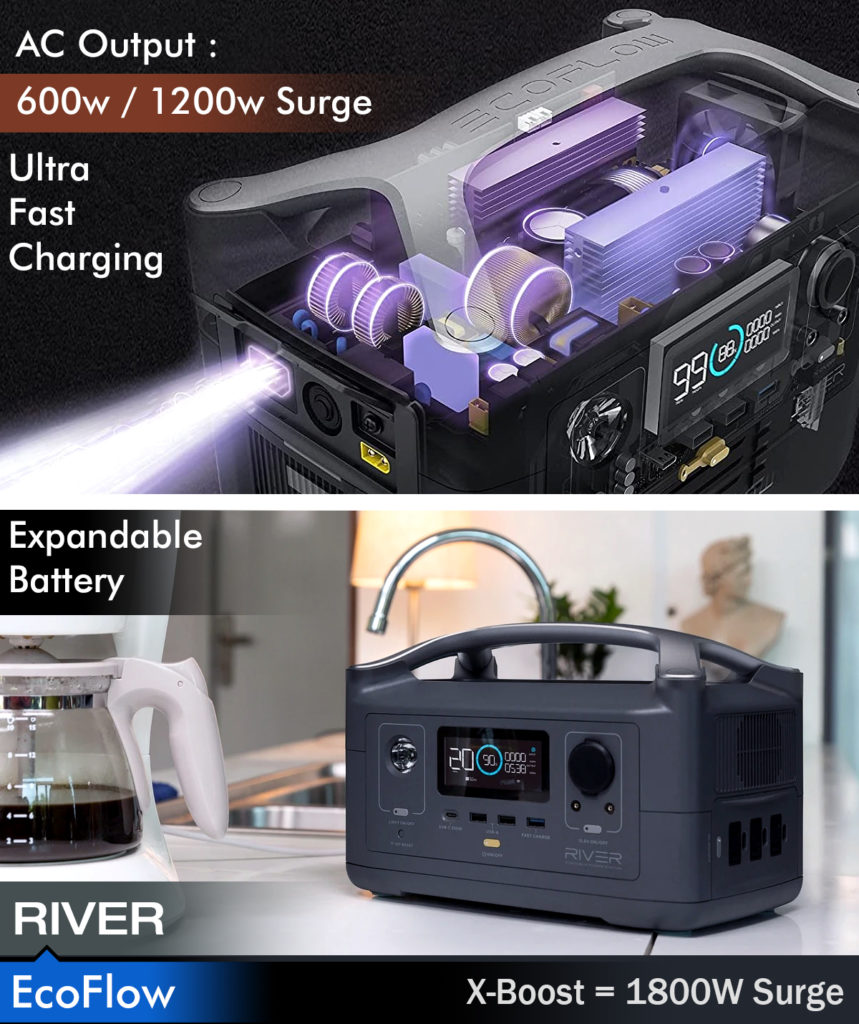
Features :
- High capacity : 75,000mAh high capacity gives you the most ultimate charging solution.
- Multiple Outputs : 3 DC outputs, 3 USB-A, 1 USB-C and 2 AC output that can charge multiple electric devices
- 3 x AC OUTLETS AND 288Wh CAPACITY SOLAR GENERATOR : The RIVER portable power station can power up to 10 devices simultaneously. With 3 pure sine wave AC outlets, the RIVER can power devices up to 1800W with the X-Boost mode on. With a capacity of 288Wh, the RIVER provides enough juice to run essential devices for hours, depending on the actual output.
- RECHARGE FROM 0% TO 80% WITHIN 1 HOUR : With EcoFlow’s patented X-Stream Technology, the smart inverter enables a fast rechargeability that takes less than 1 hour to charge from 0% to 80%, and it gets fully charged in 1.6 hours. You can switch to a quieter charging condition by turning on the “Quiet Charging” status on the APP.
- COMPATIBLE WITH 80% of HOME APPLIANCES : The X-Boost Technology’s advanced built-in algorithm enables most heavy-duty kitchen appliances and tools (up to 1800W) to operate. With X-Boost, RIVER can power 80% of essential home appliances and devices, especially those within 1200W for better using experience. The discharging rates and X-Boost mode can be monitored and controlled through the EcoFlow APP.
- Double the capacity from 288Wh to 576Wh with Extra Battery, the modular design of RIVER, is the power that grows with your needs. Designed for mobility, the 11 lbs solid yet lightweight RIVER is slightly larger than a toaster, which is perfect to take out. You can easily double the capacity of the RIVER from 288Wh to 576Wh by integrating with an Extra Battery.
- 24 MONTHS PRODUCT GUARANTEE : EcoFlow offers a 24*7 friendly customer service, and a 24 months product guarantee. What’s in the box: 1* RIVER 288Wh portable power station, 3 types of charging cable (1*1.5M AC Charging Cable, 1*1.5M Car Charging Cable, 1*1.5M MC4 to XT60 Solar Charging Cable), 1*User Guide
OVERVIEW —
From the makers of the Delta comes a power station that is small enough to carry around with you. The River is larger than Energizer’s 240Wh power station, but it also holds more energy. Does the extra capacity justify the reduced mobility compared to an Energizer PPS240W01? Let’s do some quick math. For just under 6lbs you’re getting 240Wh of capacity in the Energizer power station. The EcoFlow River packs 288Wh, but weighs 11lbs. As for dimensions, the PPS240W01 measures just 8.2 x 6.1 x 3.3 inches. In comparison, the River measures 11.3 x 7.3 x 7.7 inches. That’s like the difference between a lunchbox and a briefcase.
VIDEO | A Closer Look / EcoFlow Battery Expansion
Clearly, an increase of 20 percent in capacity is not worth carrying 83 percent more weight. But capacity is not the only advantage you get. The River has some more quirks and features hidden up its sleeve. For starters, it charges much faster than the Energizer power station. Or any other power station on the market. EcoFlow pride themselves on making the fastest charging power stations in the market. And in a way, a faster charging power station is also a more portable power station.
Hear me out, does it really matter if your power station is light when the charge time is over 5 hours? Let’s say you’re traveling and only have limited time to charge the batteries before you’re back on the road. Would you rather have a 6lb power station that charges in 5 hours or an 11lb power station that charges in 1.6 hours? Not like you’re actually carrying the thing in your hands, its sitting in your car. At home, the lighter power station is easier to carry around from room to room. And there’s no concern of charging time. But on the road? Ironically, the heavier model makes more sense as a portable power source.
Hold on, there’s more. The EcoFlow River is a more modular system than the Energizer PPS240W01. It can accept an extra battery which adds an additional 288Wh for a total of 576Wh. There is a “Max” version of the River which comes with this additional battery preinstalled from the factory. EcoFlow’s River can charge at insane speeds from solar, accepting up to 200watts from solar panels. This is eons ahead of the Energizer PPS240W01 or Jackery Explorer 240.
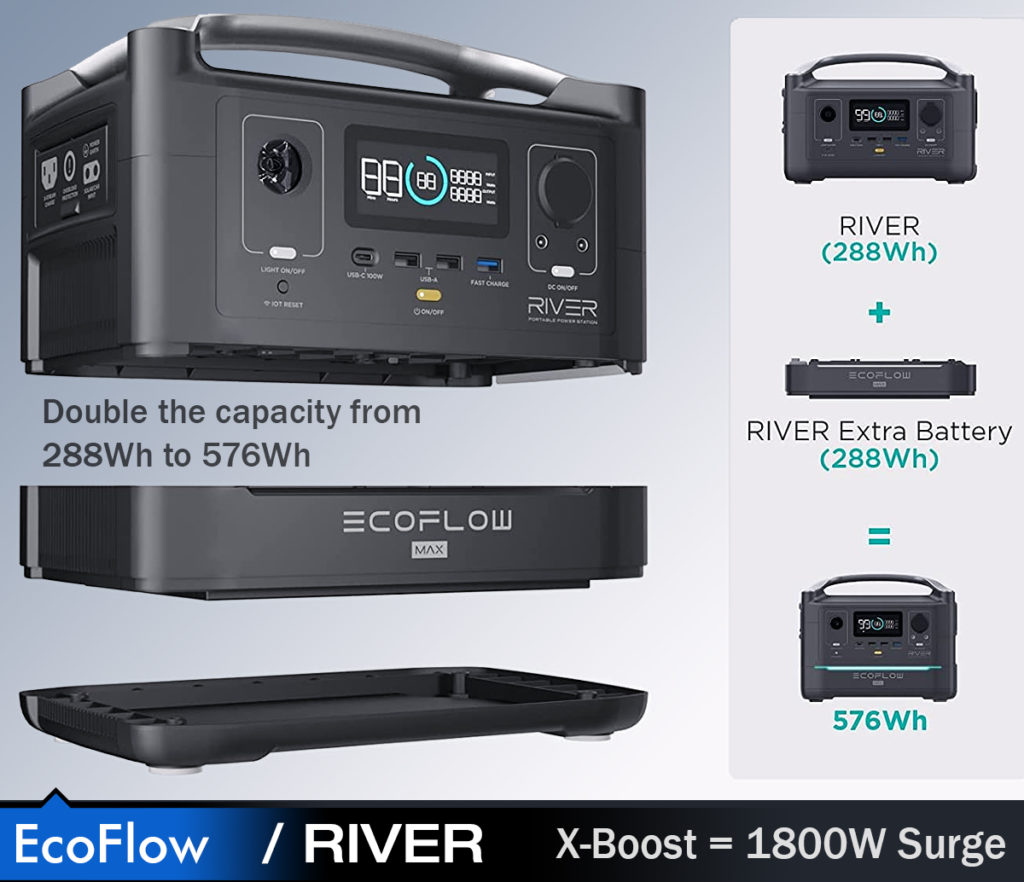
And the good news keeps on coming. Not only does the River charge at lightning speed, but it can also dump all that energy faster than its rivals. The inverter in this power station can put out 600 watts of continuous power, and 1200 watts of surge power. For a 288Wh power station those numbers make no sense. It is capable of delivering more power than a 500Wh station, even though it doesn’t have the capacity to support that output for more than a few minutes. But, you have the option. Yes, this is still a power station designed for light use. It is meant to power CPAP machines, projectors, phones, laptops, etc. However, should the need arise, you can use it to run a blender or hair dryer. Which is awesome. Now that I think about it, who runs a blender for more than a few minutes at a time?. The incredible 1200W surge power rating even lets you power certain high draw appliances (as long as they don’t have high voltage requirements).
How does EcoFlow manage to pull so much power out of such a tiny battery? Well, it’s all thanks to their X-Boost inverter technology. It is a heavy-duty inverter that is designed to be really compact so it can fit into a tiny chassis like the one on the River. Normally, an inverter this size is used in much larger power stations. The River still isn’t as compact as the Jackery Explorer 240 or Energizer PPS240W01, but it does generate 3 times the continuous power and surge power. And it charges nearly 3 times faster. Plus, it can accept an additional battery pack for twice the capacity. While the Energizer and Jackery power stations can’t run tools or kitchen appliances, this EcoFlow power station can. It also has 3 AC outlets so you can power more appliances at the same time. And for the cherry on top, you can control it remotely via Wi-Fi using an app on your phone. I think all these perks are worth the added weight and cost.
Review : Jackery Explorer 300
Best portable power station for small power needs.
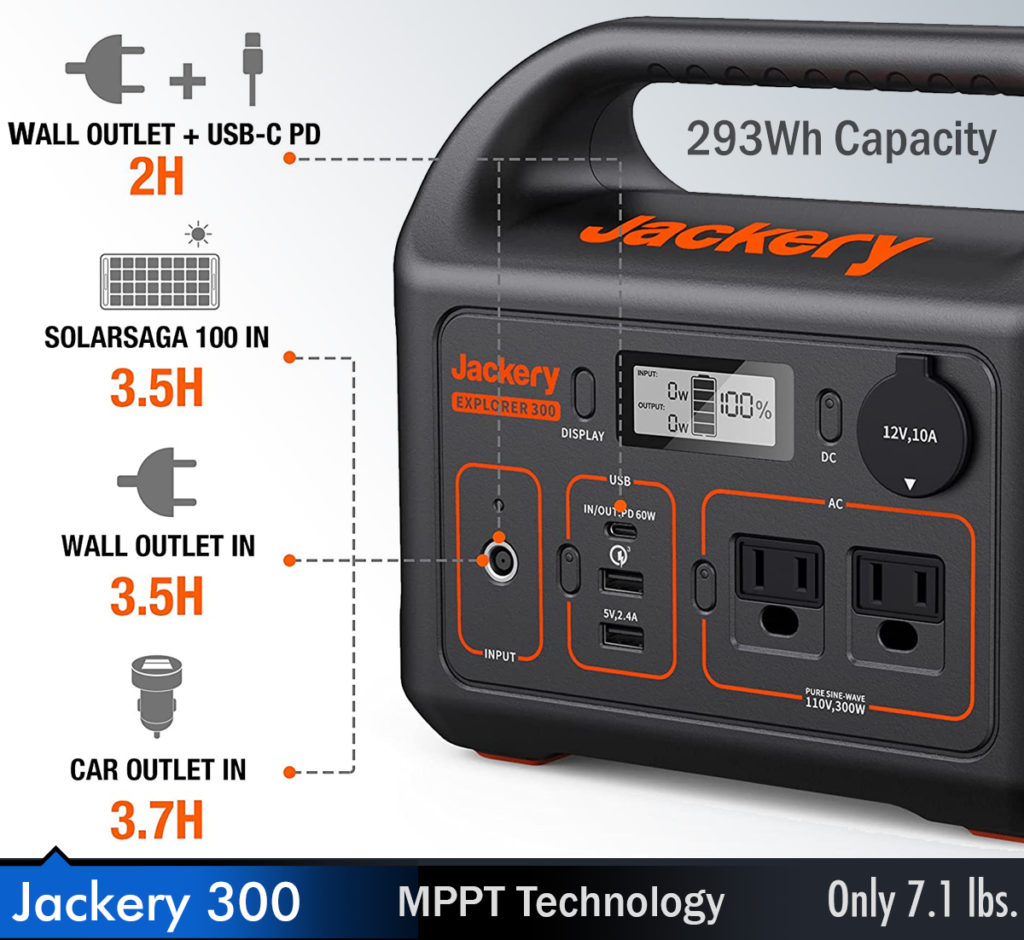
Features : (Explorer 300)
- 2.5 Hours to Full Recharge: Charging by a 90W wall charger and 60W USB-C PD charger simultaneously, the Explorer 300 can be charged to 80% in only 2 hours. Also, you can recharge Explorer 300 via a solar panel, car or a generator.
- Updated Multi-functional Outputs: 2x AC outputs(300W/peak 500W), 60W PD USB-C, QC3.0 USB-A, USB port & 12V car port. They can definitely meet your demand for different devices and save time for charging.
- Professional MPPT Technology: The professional MPPT technology provides faster solar recharge rates. The Explorer 300 can be quickly recharged from the sun in 5.5 hours with SolarSaga 100W solar panel.
- Portable and Durable: With its user-friendly design, small size, and durable handle, the Explorer 300 portable power station is lightweight, stylish, and carry-friendly.
- Reliable and Safe Power: With clean lithium-ion technology, Explorer 300 is safe and eco-friendly. Battery Management System (BMS) and pure sine wave inverter protect your sensitive devices from damage
OVERVIEW —
Jackery knew the Explorer 240 was getting old. For its capacity, the 240 really isn’t all that compact or lightweight compared to more modern power stations. And it takes forever to charge. Plus, who wants to buy a power station in the current year that doesn’t have a Type-C port? Well, all those problems are fixed in the Explorer 300. Despite its name, the Explorer 300 isn’t intended to be an upgrade but a successor to the Explorer 240. Think Goal Zero Yeti 500X vs Yeti 400, the 500x is a successor to the Yeti 400. Better battery technology and packaging means you get more capacity in a similar footprint.
And capacity isn’t even the main upgrade, the Explorer 300 charges nearly 3 times faster than the Explorer 240. On top of that, it comes with a few new ports. Like the Quick Charge USB (18W) and USB Type-C power delivery port (60W). There is an additional 120V AC outlet, making for a total of two AC outlets which lets you run more devices simultaneously. The Explorer 300 also has an improved MPPT (maximum power point tracking) charge controller, which lets it draw more power from solar panels for faster charging.
Let’s talk about size and weight first. At 7.1lbs, the Explorer 300 weighs just 7.5% more than the Explorer 240 while holding 22% more energy. Size wise, they are pretty much the same (L x W x H). But there are some major differences underneath the plastic chassis. Now, you get 300W continuous and 500W peak thanks to an improved inverter. This lets you power a TV + game console. Or a small food blender. The Explorer 300 uses lithium ion NMC cells, just like the Explorer 240. But there are more of them, resulting in higher capacity.
Now, you have a USB Type-C port with power delivery support which can handle up to 60W. The new DC charging input can accept up to 90W, compared to the 65W input on the old Explorer 240. If you look at the AC charging time, it says 4.5 hours. But, the Explorer 300 has a little trump card. It can charge from the wall and via USB Type-C simultaneously. When you combine both methods, it goes from 0 to 80 percent charge in just 2 hours. That’s getting close to EcoFlow charging speeds. Not quite there, but quite close. The original Jackery 240 had a PWM controller which later got upgraded to a MPPT controller. So if you have the original Jackery 240, the Explorer 300 will charge 3 times faster from solar panels. Newer Jackery 240 models have MPPT controllers.
The Jackery Explorer 240 has a limit of 10 amps on its 12V DC outlet, which means you can’t run stuff like air compressors. However the new Explorer 300 can handle up to 13 amps from its 12V outlet, even though the spec sheet says 10A. You can now power an air compressor or similar tool using the 12V port on the Explorer 300. And even under heavy load that maxes out its 300W inverter, the Explorer 300 generates a pure sine wave which means it is 100% safe for delicate electronics.
Is there any improvements I would like to see on this power station? Yeah, a light on the side or back would be nice to have. Also, I don’t like how Jackery makes it so you have to use their proprietary solar panels. They don’t provide MC4 to 9mm adapters, so you will have a tough time connecting generic solar panels to your Explorer 300. Why does Jackery do this? Clearly they want the extra money. Maybe it has something to do with the fact that their company was founded by a former Apple engineer. Then again, he left in 2012 so maybe it’s time to let go of the proprietary shenanigans?
Review : EF ECOFLOW River Pro / 720Wh Capacity
For When You Need More Power. Best mid-size portable power station
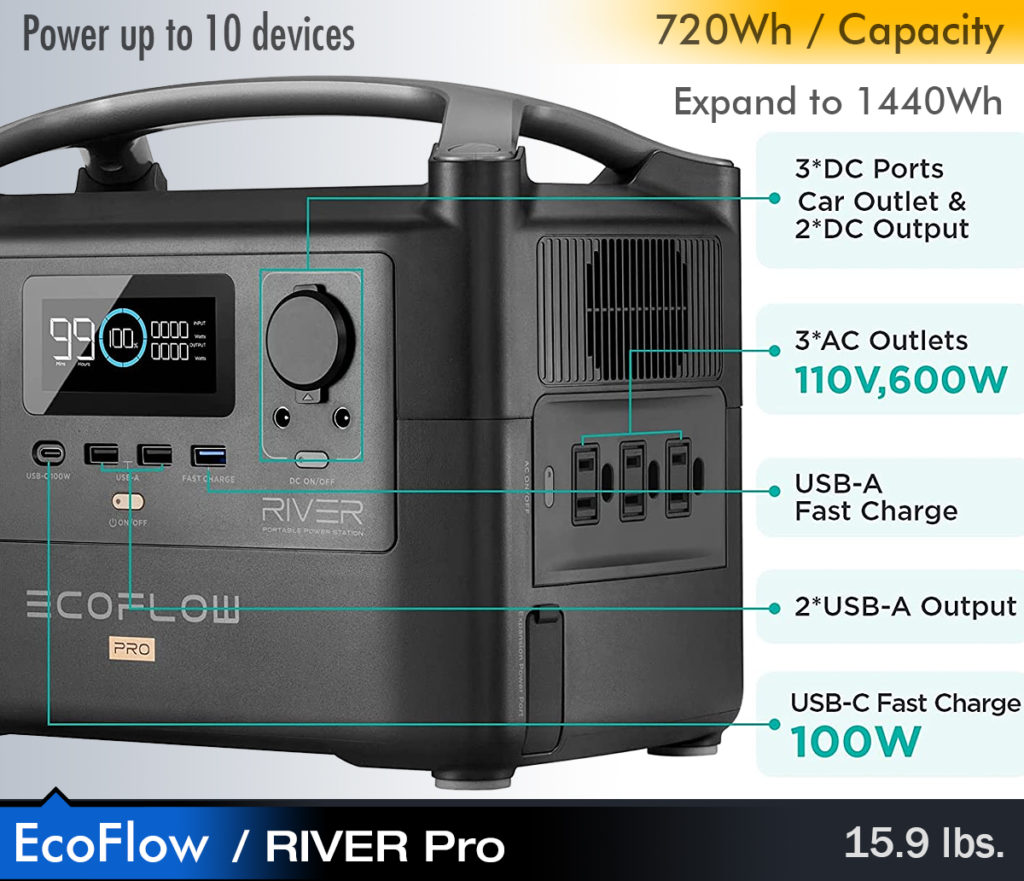
Features :
- 3 x 600W AC OUTLETS AND 720Wh CAPACITY The RIVER Pro can power up to 10 devices simultaneously with multiple outlet options, including 3 pure sine wave AC outlets. It offers up to 720Wh power and it weighs just 15.9lbs, which makes it a portable power source for adventure on the go.
- RECHARGE FROM 0-80% WITHIN 1 HOUR The patented EcoFlow X-Stream technology enables you to charge the RIVER Pro from 0%-80% within one hour and offers a full charge in just 1.6 hours.
- DOUBLE CAPACITY FROM 720Wh to 1440Wh Add a RIVER Pro Extra Battery to double the capacity from 720Wh to 1440Wh. This is ideal for situations like traveling, camping, or group outdoor activities where you need more power for more devices.
- POWER A WIDE RANGE OF APPLIANCES The RIVER Pro can power some devices up to 1800W with the X-Boost mode on, which lets you power about 80% of essential devices like kitchen appliances and DIY tools. Use devices below 1200W for the best product use.
OVERVIEW —
The base version of the River is fine for charging your drone, phone, camera, etc. but it lacks the capacity to run appliances or tools. Yeah, the 600W inverter is awesome in such a compact package but you will run out of juice pretty quick when you hook up something like a corded drill. The River Pro is a real step-up from the base model with 720Wh of capacity. And it only weighs 5.8lbs more. That’s 52% more weight for 150% more capacity. I will take that trade any day of the week. In terms of features, you get everything the base version has. Wi-Fi connectivity, X-Stream charging, X-Boost inverter tech, etc.
The River Pro seems to have a different battery management system because it lasts 800 cycles before getting to 80% capacity. In comparison, the River lasts 500 cycles (which is the standard figure for lithium ion). So you get slightly more lifetime out of your River Pro. Still, it doesn’t compare to the insane 2000 cycles of the Energizer PPS240W01. That’s the power of lithium iron phosphate batteries. Inverter type is also the same between the River and River Pro. Both have 600W continuous, 1200W surge inverters with 3 AC outlets. However, the River Pro can charge from a max input of 660 watts. In comparison, the River can handle “only” 250 watts of input while charging.
Because of its insane 660W charge input, the River Pro charges from zero to full in just 1.6 hours. That’s the exact same time as the River, despite having 150% more capacity. EcoFlow strikes again with their amazing charging speeds, which makes this a truly excellent power station for people on the move. The River Pro isn’t just a regular River with a larger battery. It has a better weight-to-capacity ratio, charges within the same time despite having a much larger battery, and has more endurance (800 cycles vs 500).
Who is this for? Say you want to power your fridge or printer for several hours; a base model River just won’t cut it. While it has the inverter, it lacks the battery capacity. Oh, and the River Pro can accept an extra 720Wh battery which brings the total capacity to 1440Wh. This is perfect for tailgating, camping, and other group outdoor activities where a 288Wh River can’t handle the demand. The River Pro can also function as a UPS for your workstation or data server. It can power a 350 desktop for over 2 hours.
Tech Specs / EF EcoFlow River Pro
- Net Weight : 16.8 lbs (7.6kg)
- Size : 11.4 x 7.1 x 9.3in (28.9 x 18.0 x 23.5cm)
- Charge Temperature : 32 to 113°F +/- 5°F (0 to 45°C +/- 3°C)
- Discharge Temperature : -4 to 113°F +/- 5°F (-20 to 45°C +/- 3°C)
- Warranty : 24 months
- Charging Method : AC Wall Outlet, 12V Car Adapter, Solar Panel(s)
- Full Recharge Time : 1.6 Hours (AC) 6.5 Hours (12/24V Car Adapter) 4.5-9 Hours (Using 2x 110W Solar Panels in parallel with direct sunlight) 7.5-15 Hours (Using 1x 160W Solar Panel with direct sunlight)
- Capacity : 720Wh (28.8V)
- Cell Chemistry : Lithium-ion
- Shelf Life : 1 year (once fully charged)
- Cycle Life : 800 cycles to 80%+ capacity
- Management Systems : BMS, Over Voltage Protection, Overload Protection, Over Temperature Protection, Short Circuit Protection Low Temperature Protection, Low Voltage Protection, Overcurrent Protection
- Testing and Certifications : UL Standard, CE, FCC, RoHS, RCM
- AC Charge Input Power : X-Stream Charge 660W Max
- AC Charge Input Voltage : 100-120Vac (50Hz/60Hz)
- Solar Charge Input : 200W 10-25Vdc 12A Max
- Car Charger : 12Vdc 8A Max
- AC Output (x3) : 600W (Surge 1200W) total, 120Vac ( 50Hz/60Hz)
- USB-A Output (x2) : 5Vdc, 2.4A, 12W Max per port
- USB-A Fast Charge (x1) : 5Vdc, 9Vdc, 12Vdc, 2.4A, 28W Max
- USB-C Output (x1) : 5Vdc, 9Vdc, 12Vdc, 15Vdc, 20Vdc, 5A, 100W Max
- Car Power Output (x1) : 136W, 13.6Vdc, 10A Max
- DC5521 Output (x2) : 13.6Vdc, 3A Max per port
